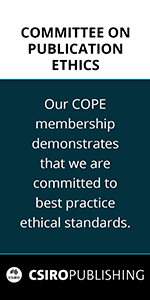Australian Journal of Zoology
Volume 61
Number 1 2013
A Tribute to Des Cooper
This introduction pays tribute to the late Professor Desmond Wishart Cooper, a leading researcher whose work spanned the fields of genetics, reproduction, conservation and wildlife management, and sets the scene for the papers presented in this special issue, all of which report or review research that was inspired by Des’ work in the field of zoology. This special issue is dedicated to the scientific achievements of Des Cooper, and the pivotal role he has played in mentoring young biologists, which is perhaps his greatest legacy.
Photo courtesy of Tina Cooper.
Professor Des Cooper was the inspiration behind decades of work characterising marsupial genes and chromosomes, which culminated in sequencing the genomes of animals that represent independent experiments in evolution. In particular, marsupial sex chromosomes have provided new insights into the evolution of mammalian sex chromosome organisation, function and regulation.
Photo by R. Toder and R. O’Neill.
Professor Des Cooper was among the first scientists to discover imprinted X chromosome inactivation in marsupials. This review revisits his seminal studies and highlights the progress that has been made towards unravelling the evolutionary origin of X chromosome inactivation in marsupials.
Photo by Emily Miller.
Marsupial immune responses were previously touted as ‘primitive’, but we now know that the marsupial immune system is complex and on par with that of eutherian mammals. In this paper, we review the field of marsupial immunology focusing on the characterisation of immune gene sequences, which will allow us to more accurately study health and disease in marsupials. This paper is dedicated to our mentor, Professor Des Cooper.
Photo by Katrina Morris.
In this review, we explore the unique features of the marsupial pouch and highlight the research questions that remain unanswered regarding this unique marsupial attribute. We discuss the advantages of the marsupial reproductive strategy and the potential role of the pouch in mammalian diversification.
The ability of bats to harbour highly pathogenic viruses with no clinical signs of disease has resulted in a resurgence of interest in bat biology and virus–host interactions. Here we review the biology of Australian pteropid bats and their pathogens, summarising current knowledge of bat-borne diseases, bat ecology, ethology and immunology.
Photo by Susanne Wilson.
Examination of Y chromosome markers provides important insights into male-mediated processes. In the western grey kangaroo, Y-linked markers have revealed the male contribution to population history, genetic structuring and hybridisation events with the eastern grey kangaroo which were not predicted from an examination of maternally and biparentally inherited markers.
Photo by Linda Neaves.
Tammar wallaby subspecies display a difference in 1080 tolerance. To elucidate the genetic basis behind this difference, we examined the gene encoding the enzyme inhibited by 1080, but failed to identify a sequence difference between subspecies. A genome-wide approach will be required to determine the gene(s) involved.
Photo by Catherine Herbert.
This study reports on basic biological parameters for an urban brushtail possum population in Sydney, Australia. The age structure of the population was indicative of high male turnover. Reproduction was seasonal, peaking in autumn. Attempts to render individual females infertile through application of a long-acting contraceptive implant were successful, with reproduction inhibited for more than 18 months in 100% of females.
Photo by Catherine Herbert.
This paper reports the incidence of road-killed possums in the Ku-ring-gai area of Sydney. Road-kill hot spots are identified with the bush/urban interface being the site of the majority of road deaths. Factors contributing to these hot spots are discussed, and a mitigation strategy implemented.
Photo by Tracey Russell.
Brushtail possums have been described as prized native wildlife through to pests. We report on the increasing decline of the brushtail possum in certain areas and their overabundance in others. Attitudes towards these animals and the ‘fit’ between values, attitudes and prevailing governance are also assessed.
Photo by Tracey C. Russell.
Loss of biodiversity is a critical conservation issue of our generation. Twenty-two Australian mammal species have become extinct in the last 200 years, with the most recent one in 2009. Although zoo-based breeding programs as part of a recovery plan can ‘buy’ time for some critically endangered species, for others they will have limited relevance.
Photo courtesy of Healesville Sanctuary, Victoria.
















